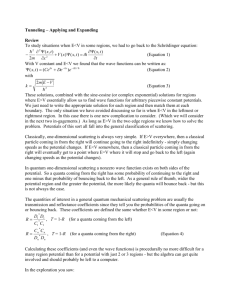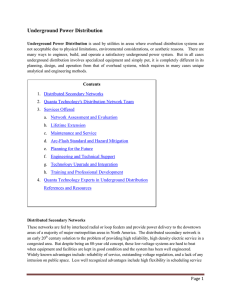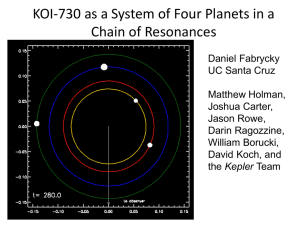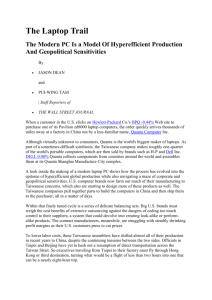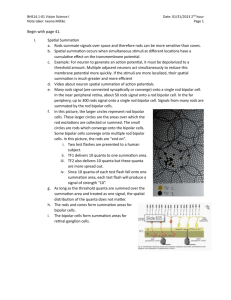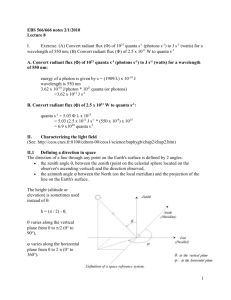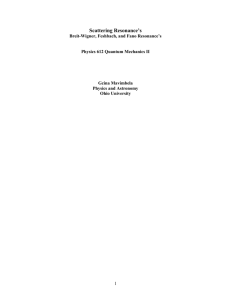General Scattering and Resonance – Getting Started
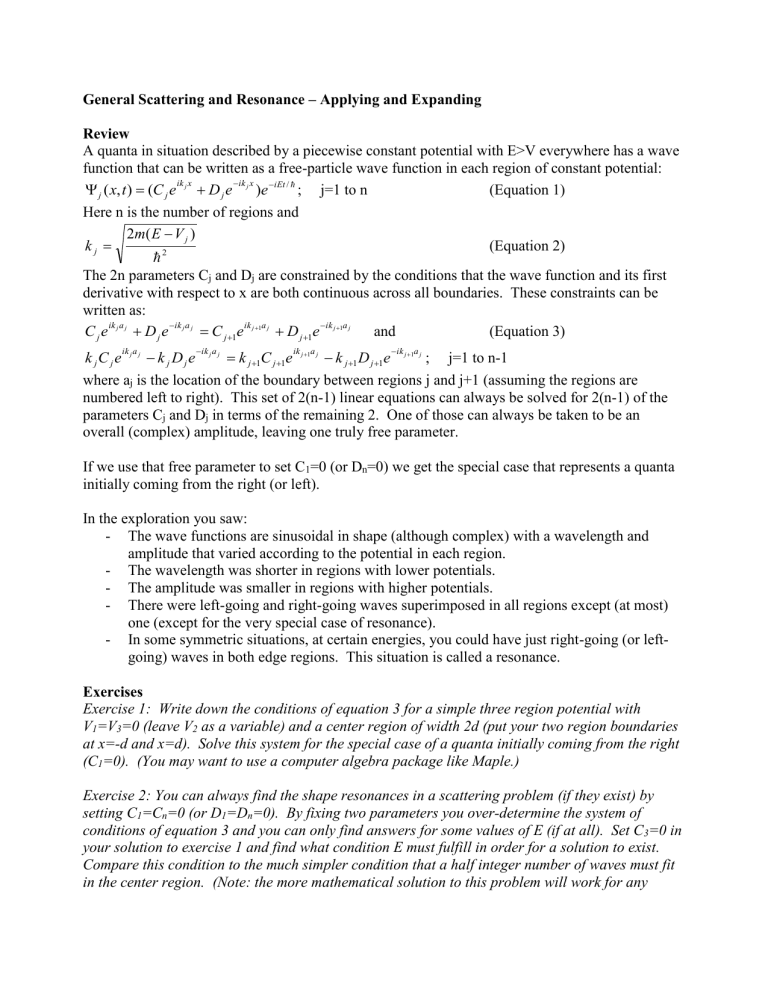
General Scattering and Resonance – Applying and Expanding
Review
A quanta in situation described by a piecewise constant potential with E>V everywhere has a wave function that can be written as a free-particle wave function in each region of constant potential:
j
( x , t )
( C j e ik j x
D j e
ik j x
) e
iEt /
; j=1 to n (Equation 1)
Here n is the number of regions and k j
2 m ( E
V j
)
(Equation 2)
2
The 2n parameters C j
and D j
are constrained by the conditions that the wave function and its first derivative with respect to x are both continuous across all boundaries. These constraints can be written as:
C j e ik j a j
D j e
ik j a j k j
C j e ik j a j
C k j
D j e
ik j a j j
1 e ik j
1 a j
k
j
1
C j
1 e
D j
1 e
ik j
1 a j ik j
1 a j
k
and j
1
D j
1 e
ik j
1 a j
(Equation 3)
; j=1 to n-1 where a j
is the location of the boundary between regions j and j+1 (assuming the regions are numbered left to right). This set of 2(n-1) linear equations can always be solved for 2(n-1) of the parameters C j
and D j
in terms of the remaining 2. One of those can always be taken to be an overall (complex) amplitude, leaving one truly free parameter.
If we use that free parameter to set C
1
=0 (or D n
=0) we get the special case that represents a quanta initially coming from the right (or left).
In the exploration you saw:
The wave functions are sinusoidal in shape (although complex) with a wavelength and amplitude that varied according to the potential in each region.
The wavelength was shorter in regions with lower potentials.
The amplitude was smaller in regions with higher potentials.
There were left-going and right-going waves superimposed in all regions except (at most) one (except for the very special case of resonance).
In some symmetric situations, at certain energies, you could have just right-going (or leftgoing) waves in both edge regions. This situation is called a resonance.
Exercises
Exercise 1: Write down the conditions of equation 3 for a simple three region potential with
V
1
=V
3
=0 (leave V
2
as a variable) and a center region of width 2d (put your two region boundaries at x=-d and x=d). Solve this system for the special case of a quanta initially coming from the right
(C
1
=0). (You may want to use a computer algebra package like Maple.)
Exercise 2: You can always find the shape resonances in a scattering problem (if they exist) by setting C
1
=C n
=0 (or D
1
=D n
=0). By fixing two parameters you over-determine the system of conditions of equation 3 and you can only find answers for some values of E (if at all). Set C
3
=0 in your solution to exercise 1 and find what condition E must fulfill in order for a solution to exist.
Compare this condition to the much simpler condition that a half integer number of waves must fit in the center region. (Note: the more mathematical solution to this problem will work for any
scattering case where resonances exist – the simpler solution only works for this very simple problem.)
Exercise 3: The concept of transmittance and reflectance coefficients, T and R, can be extended to any scattering problem. For a piece-wise constant potential with a quanta initially coming from the right(C
1
=0) the reflectance coefficient is defined as R
C n
*
C n
D n
*
D n and represents the probability of the quanta being reflected back to the right and the transmittance coefficient can always be calculated as T=1-R and represents the probability of the quanta making it all the way through to the left region and continuing on to the left. (For a quanta initially coming from the left the formula is R
D
1
*
D
1
C
1
*
C
1
.) Calculate R and T for the situation described in exercise 1. For electrons with V
2
=2eV and d=1nm, plot R and T vs. E for energies between 2eV and 10eV. For electrons with V
2
=-2eV and d=1nm, plot R and T vs. E for energies between 0eV and 10eV. (You should be able to identify the resonances on this plot. Also note that the higher energies are more like what you expect classically.)
Projects
Project 1: Repeat exercises 1-3 for a non-symmetric three region piece-wise constant potential.
(e.g. V
1
=0 but V
2
≠V
3
≠0). Compare results to the symmetric case.
Project 2: Mathematically find the resonance energies for the 5-region potential of activity 10.
Compare to the values you found in WFE. (Note: you probably will want to use a computer to solve this project!)
